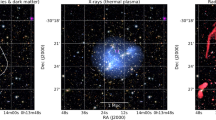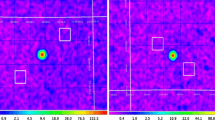Abstract
The results of a study of the fine structure of an image of a microwave radiation source, which is usually located in the solar atmosphere above active regions, are presented. The source is equal to the whole active region in size (2–5 arcmin); it is conventionally called a “halo”. Observations of two active regions of different morphological types (NOAA 7123, 1992 and NOAA 11142, 2011) with a high angular resolution (2–5 arcsec) were used. According to these observations, the majority (>50%) of the halo consists of diffused optically transparent thermal plasma. A brighter underlying region shines through it; in the case of NOAA 7123, this region looks like a two-ribbon structure along the magnetic field neutral line with a radiation depression along the Hα filament. In the case of NOAA 11142, the halo brightening regions are associated with regions of cluster of small sunspots and pores. The conclusion is drawn that the brighter component of the halo is due to the cyclotron radiation of coronal plasma in a relatively weak magnetic field (600–800 Gs).
Similar content being viewed by others
References
Agalakov, B.V., Borisevich, T.P., Opeikina, L.V., et al., Active region NOAA 7123 by “eyes” of VLA, RATAN-600, SSRT, and BPR: Difference in the results and probable causes, Trudy Vseross. ezhegodnoi konf. po fizike Solntsa “Solnechnaya i solnechno-zemnaya fizika 2010” (Proc. All-Russian Conf. on Solar Physics “Solar and SolarTerrestrial Physics-2010”), St. Petersburg: CAO RAS, 2010, pp. 23–26.
Akhmedov, Sh.B., Bogod, V.M., Borovik, V.N., et al., The structure of the solar active regions from VLA and RATAN-600 observations in 1982, JUL-Part One-AR:3804, Astrofiz. Issled., 1987, vol. 25, pp. 105–134.
Baldin, S.V. and Garaimov, V.I., RATAN-600 radio telescope in the 24th solar-activity cycle. III. System of data acquisition and control of the solar spectral facility, Astrophys. Bull., 2011, vol. 66, no. 3, pp. 371–378.
Bogod, V.M., Alesin, A.M., and Pervakov, A.A., RATAN-600 radio telescope in the 24th solar-activity cycle. II. Multi-octave spectral and polarization high-resolution solar research system, Astrophys. Bull., 2011, vol. 66, no. 2, pp. 205–214.
Finkel’shtein, A.M., Rakhimov, I.A., D’yakov, A.A., et al., Observations of the solar eclipse of January 4, 2011 at two RT-32 radio telescopes (Svetloye and Zelenchukskaya): First results, Trudy IPA RAN, 2012, no. 25, pp. 154–159.
Garaimov, V.I., Processing of 1D Data Vectors in OS Windows, WORK SCAN Software, Version 2.3, Preprint of Special Astrophysical Observatory, 1997, preprint no. 127T.
Korzhavin, A.N., Opeikina, L.V., and Peterova, N.G., Transition region above sunspots inferred from microwave observations, Astrophys. Bull., 2010, vol. 65, no. 1, pp. 60–74.
Kundu, M.R., Structures et propriétés des sources d’activité solaire sur ondes centimétriques, Ann. Astrophys., 1959, vol. 22, pp. 1–100.
Vourlidas, A., Bastian, T.S., and Aschwanden, M.J., The structure of the solar corona above sunspots at inferred from radio, X-ray, and magnetic field observations, Astrophys. J., 1997, vol. 489, no. 1, pp. 403–425.
Zlotnik, E.Ya., The role of energetic electrons in the generation of the S-component of the solar radio emission, Izv. Vyssh. Uchebn. Zaved., Radiofiz., 1970, vol. 13, pp. 678–683.
Author information
Authors and Affiliations
Corresponding author
Rights and permissions
About this article
Cite this article
Peterova, N.G., Opeikina, L.V. & Topchilo, N.A. “Halo” type sources from microwave observations with high angular resolution. Geomagn. Aeron. 54, 1053–1057 (2014). https://doi.org/10.1134/S0016793214080155
Received:
Published:
Issue Date:
DOI: https://doi.org/10.1134/S0016793214080155




